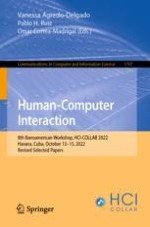This book constitutes the refereed proceedings of the 8th Iberoamerican Workshop on Human-Computer Interaction, HCI-COLLAB 2022, which took place in Havana, Cuba, in October 2022.
The 15 full papers presented in this volume were carefully reviewed and selected from 53 submissions. The papers deal with topics such as emotional interfaces, usability, video games, computational thinking, collaborative systems, IoT, software engineering, ICT in education, augmented and mixed virtual reality for education, gamification, emotional interfaces, adaptive instructional systems, accessibility, use of video games in education, artificial intelligence in HCI and infotainment, among others.
